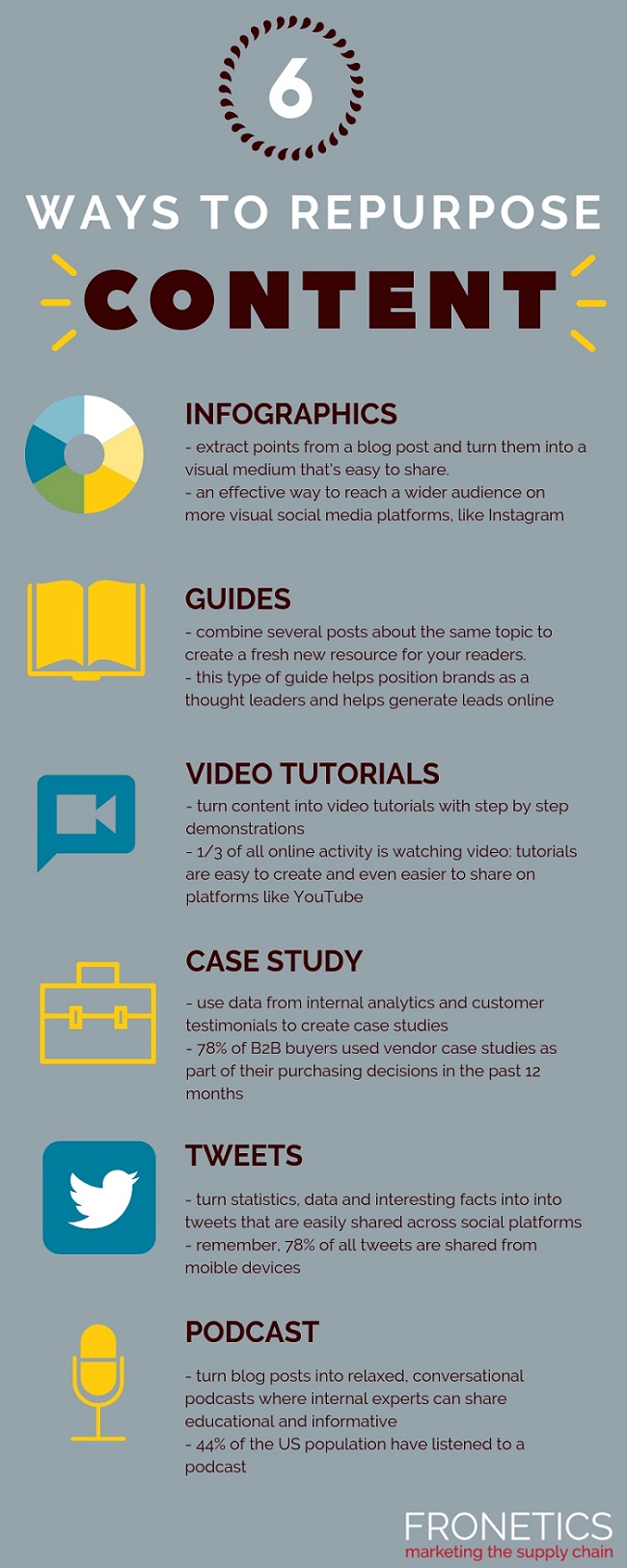
by Fronetics | Dec 4, 2018 | Blog, Content Marketing, Logistics, Marketing, Strategy, Supply Chain
Repurposing content is an efficient way to reach a broader audience and build brand awareness.
You spent hours pouring over stats and interesting facts for a blog post. Don’t let all of that effort fall to the wayside. Breathe new life — and reach new audiences — by repurposing that content into engaging new formats.
Some social users like video, while others prefer pictures or podcasts. Taking content and changing its original format is just smart business. Repurposing high-quality content saves marketers time and money and helps to reach a broader audience.
Be picky
Not all of your blog posts and content get the same attention, and that’s ok. Some pieces will resonate more, increasing engagement and driving website traffic.
Run analytics on your content and see what pieces have performed the best. Use tools like Google Analytics to determine your most popular blog posts, your most engaged tweets, or your most viewed videos. This data will help you decide which content should be repurposed. The idea is to take one piece of content and gain visibility and expand your audience by turning it into multiple pieces of content.
The Rule of 7
Repurposing content isn’t just about cutting and pasting content. Have you heard of the Rule of 7? The Rule of 7 is a marketing principle that states your prospects need to encounter your content seven times before they take notice. That’s right, seven times.
[bctt tweet=”The Rule of 7 is a marketing principle that states your prospects need to encounter your content seven times before they take notice. That’s right, seven times.” username=”Fronetics”]
Repurposing content is a great way to take high-quality content and continue to get it in front of audiences without seeming redundant. HubSpot reports that brands who blog around 16 times or more per month get 3.5 times more traffic and 4.5 times more leads than businesses that blog fewer than four times a month. Frequency clearly gets results, but it can also be incredibly time-consuming to create new content 16 times every month. Repurposed content can help your marketing team increase frequency while focusing on quality.
Infographic: 6 ways to repurpose content

(Made with Canva)
Takeaway
How much value does your company put on content? It may be even more important than you think. Use these tips to repurpose high-quality content or yet better, start creating content with these tips in mind. Thinking about a topic and how you can turn that topic into multiple pieces of content will help your hard work go further and perform better.
Related posts:


by Fronetics | Dec 3, 2018 | Blog, Content Marketing, Logistics, Marketing, Social Media, Supply Chain
Social media is a valuable tool for businesses, but only if they use it to their best advantage and avoid these three common mistakes.
81% of small and medium businesses use a social platform. And we all understand why. By 2019, it is estimated that there will be around 2.77 billion social media users around the globe. That’s a lot of potential customers.
[bctt tweet=”There’s no disputing social media is an effective way to increase brand awareness and generate leads. But it can be fairly useless if your company isn’t doing it right.” username=”Fronetics”]
So, there’s no question as to why companies are jumping on the social media bandwagon. And there’s no disputing social media is an effective way to increase brand awareness and generate leads. But it can be fairly useless if your company isn’t doing it right.
Top three social media mistakes companies make
Mistake #1: Using objectives instead of strategy
Social media platforms are continually making changes and updates to improve the user experience. In order to weather these changes and keep your audience engaged, it’s imperative to have a clear strategy that includes types of content, frequency, and pillar topics.. Posts should reflect your brand, so make sure posts follow style guidelines and reflect your specific tone.
A strategy will also help prove ROI. Social Media Examiner’s 2018 Social Media Marketing Industry Report found that only 44% of marketers agree that they know how to measure social media ROI. That means two-thirds of marketers don’t know whether or how much their marketing efforts are paying off when it comes to the use of social media. A strategy that incorporates defined goals, tracking and measuring will help prove data-driven ROI and improve your social media presence.
Mistake #2: Using the most popular social media platforms
Not all social media platforms are created equal. In fact, all social media channels have a differentiating quality that makes them appealing to specific audiences. Start by identifying where your target audience is spending their time. For example, 81% of millennials view their Twitter account on a daily basis. If your company is looking to capture millennials as leads, your social media efforts should certainly include Twitter.
Once you’ve determined where you should be posting, concentrate on creating content that caters to those specific platforms. Lots of companies post the same content across all of the apps they use. We understand how easy that is for marketers, especially with automation tools. But the foundation of social engagement is authenticity, something that is hard to achieve when posts are the same across all channels. Work to create content — including video and images — that caters to specific platforms to build brand awareness and loyalty.
Mistake #3: Promoting instead of connecting
Social media is all about engagement. Users don’t want to engage with brands that are pushing their products and services. Users want informative, interesting, and yes, even fun content. Companies need to focus on creating content that leaves their users wanting more.
Companies that are succeeding on social media are finding innovative and creative ways to relate to users. When you engage and get users involved in your story, you create long-lasting customer relationships. Storytelling creates an emotional bond with your company and drives brand loyalty.
Greg Hadden, executive creative director of Motive Made Studios, sums up the power of connecting with users: “What often gets lost is the fact that good storytelling is potent stuff. It has the power to make people want to believe and to belong, which is the goal of all storytellers. We’re all selling something, be it an idea, an exploration of the human condition, or say, a vacuum cleaner. It’s no mistake perhaps that good stories often create products.”
Final thoughts
Social media platforms are a powerful resource that can help your business grow. But they have to be used correctly. Creating a documented strategy will help shape your brand’s social media presence and give you milestones to test and tweak your progress. Need help creating a social media strategy? Let us help.
Related posts:


by Fronetics | Nov 29, 2018 | Blog, Content Marketing, Current Events, Marketing, Social Media
Also in social media news, November 2018: Instagram tests options to promote stories on business pages, Pinterest unveils updates to self-serve ad tools, and Facebook tests advanced analytics for Instagram.
November was the month of social media updates and the development of new tools aimed at helping brands. Though Facebook has vowed to boost content for individuals – think posts from friends and family – they are also making significant strides in helping businesses gain reach and increase engagement after a slow start to the calendar year.
For example, Instagram tested options to help promote Stories on Business pages. What does this mean for your company? Soon brands will have the ability to get Stories in front of new audiences, increasing followers and engagement. Building lasting relationships with prospects on social media means presenting your brand in a visually engaging way while linking them to useful and relevant information.
[bctt tweet=”Building lasting relationships with prospects on social media means presenting your brand in a visually engaging way while linking them to useful and relevant information.” username=”Fronetics”]
Here’s your social media news for November 2018.
Facebook announces third-quarter earnings report
Facebook just revealed it has 1.49 billion daily active users in its quarterly earnings report. When you combine Facebook, Messenger, Instagram, and Whatsapp, monthly active users total 2.6 billion. Though these numbers are the highest of any social media platform, Facebook significantly dropped active users in Europe last quarter.
Mark Zuckerberg, Facebook CEO, noted a growing shift in social media engagement including an increased focus on private messaging and stories. Another shift? Video. “We’re seeing video grow dramatically across the ecosystem, and while Watch is now growing very quickly, we’re well behind YouTube and still working to make this a unique people-centric experience.” writes Zuckerberg. Facebook will also continue to improve safety and security measures to address increased threats.
YouTube premieres now available to all users
YouTube premieres is a feature that lets you and your viewers watch and experience a new video together, much like a movie or TV show premiere. Premiering your video allows you to schedule a video upload and to create buzz around the video with a shareable watch page. Premieres originally debuted to specific creators but is now available to all users. Businesses can invite fans to use Live Chat as it counts down to the premiere of a new video that users can watch together while answering questions and responding to comments.
LinkedIn offers new integration tool with Google Campaign Manager
LinkedIn announced a measurement integration tool with Google Campaign Manager, a part of Google Marketing Platform. This new tool allows businesses to see LinkedIn ad performance alongside other paid advertising, and get attribution for LinkedIn ads across all impressions and interactions. “Earlier this year, we launched this integration for a few ad formats, but today – we are launching it for Sponsored Content,” writes LinkedIn.
Instagram tests Promote: a new way to share Stories on business pages
Instagram is giving businesses a new way to share Stories without much effort. Promote, a new ad type, allows admins to “auto-target users similar to their followers, specific locations, or use all of Instagram’s targeting parameters to inject their stories into the queue of more users.” The ads will also link back to a business’s Instagram profile or webpage. Instagram confirmed to TechCrunch that Promote for Stories is similar to Facebook’s Boost option that lets businesses pay to show their posts to more users instantly.
Facebook tests advanced analytics for Instagram
Facebook introduced Instagram Analytics, a new part of Facebook Analytics. With Instagram Insights, businesses can already see how audiences interact with posts and Stories, but what happens next and what does that mean for your business? Now with Instagram Analytics, businesses can track “lifetime value and retention rates for people who do or don’t interact with their content and create audience segments to see if people who commented on a particular post generate more value for them.” They can also analyze how audiences overlap with website visitors and Facebook followers.
Pinterest updates self-serve ad tools
Pinterest is working to make it easier for brands to reach the right audiences with their ads. In October, Pinterest unveiled updates to its Self-Serve Ads Manager to streamline the campaign creation process and give companies tools to track their progress on the app. “Over the past year, we’ve used your feedback to redesign our ad tools so businesses on Pinterest can define and size audiences, create ads and pull reports with ease.” The new features are currently available in English-speaking markets with a Pinterest business profile.
Related posts:


by Jennifer Hart Yim | Nov 28, 2018 | Blog, Content Marketing, Logistics, Marketing, Strategy, Supply Chain, Talent
Great people don’t always focus on expressing their superpowers at work out of a fear of limiting their scope. Here’s how employers can identify and coach employees to work to their fullest potential.
This guest post comes to us from Argentus Supply Chain Recruiting, a boutique recruitment firm specializing in Supply Chain Management and Procurement.
In people management and hiring, we might assume that we’re emphasizing what our employees are best at. “Play to your strengths” is one of the biggest truisms of business, and life in general. If the people we’re managing – or hiring – are talented, we might assume that they’re working to their full potential in their roles. The cream rises to the top in any organization, but how often are we failing to hire and manage talented people based on what they’re truly best at?
A great new article from executive coach Whitney Johnson in the Harvard Business Review details how employers can help their teams play to their strengths. More than strengths, actually: Johnson offers strategies for identifying and coaching employees based on their superpowers – the things that come most easily, the things that those employees are not always willing to boast about.
[bctt tweet=”People sometimes undervalue their own superpowers because the tasks associated with them feel “too easy” compared to hard-won skills. But let people focus on their superpowers and real opportunities for innovation start to spring forth.” username=”Fronetics”]
As Johnson puts it, people sometimes undervalue their own superpowers because the tasks associated with them feel “too easy” compared to hard-won skills. But let people focus on their superpowers and real opportunities for innovation start to spring forth.
Often you can spot superpowers in the wild; some people are such high performers that it’s obvious what they’re best at, and they’ve found their way into a role that utilizes those skills. But the HBR article makes the point that great people don’t always focus on expressing their superpowers at work out of a fear of limiting their scope. It’s rare that you find someone who’ll put what they’re truly a genius at on their resume – either out of a desire not to boast, or to present a more balanced profile.
The article identifies some strategies for managers to identify their team’s “superpowers.” They encourage managers to ask their employees a few key questions:
- What exasperates you? Ask people if there’s anything in their job that frustrates them when other people don’t understand it easily.
- What compliments do you dismiss? The article makes a great point that people tend to downplay the things that they’re best at – the things that come most naturally to them – out of humility or because they feel “easy.” If someone regularly dismisses compliments around a certain task or deliverable, that’s a sign that thing might be their superpower.
- What do you think about when you have nothing to think about? In downtime, our brains regularly come back to the things that stimulate us most – the things our minds gnaw at that we can’t let go. Leaders should try to find out their employees’ fixations, because – through coaching – these can develop into passions and ultimately superpowers.
But why stop at coaching and development? We think that companies should strive to adopt this approach for hiring as well: as much as possible they should hire employees for their superpowers, rather than their ability to carry out an over-wide range of tasks.
For example, in Strategic Procurement: is someone particularly elite at communicating and building relationships? Assign them specifically to build buy-in from internal stakeholders across the business, and act as a point-person between those internal clients and the sourcing group. Leave the sourcing to those whose “superpowers” are evaluating the supplier marketplace, or negotiation, rather than structuring your department around a bunch of generalists.
Does someone have a deep understanding of a particular category, for example marketing spend, perhaps from working on the other side of the fence? Hire them for that category. These are just a few examples of how we think companies can adopt the “superheroes” approach to hiring.
Companies should tailor job descriptions towards key deliverables, and consider including the questions mentioned above in the job interview process, as a means of trying to uncover what comes easiest to job candidates – which also happens to be the areas where they’re most likely to innovate.
Budgets, organizational structure, and directives from senior leadership will often be impediments to this approach, but specialization is the name of the game in improving efficiency, which is after all what Supply Chain Management and Procurement are all about.
Related posts:


by Fronetics | Nov 27, 2018 | Blog, Content Marketing, Current Events, Logistics, Marketing, Social Media, Supply Chain
With the 2018 holidays approaching fast, customers are pulling out their wallets and getting ready to increase holiday spending by at least 4.3%.
The National Retail Federation (NRF) is estimating that holiday sales will be up 4.3-4.8% over 2017, for a total of $717.45 billion to $720.89 billion. “Thanks to a healthy economy and strong consumer confidence, we believe that this holiday season will continue to reflect the growth we’ve seen over the past year,” says NRF President and CEO Matthew Shay.
[bctt tweet=”The National Retail Federation (NRF) is estimating that holiday sales will be up 4.3-4.8% over 2017, for a total of $717.45 billion to $720.89 billion.” username=”Fronetics”]
Shopping insights
Consumers are planning to spend an average total of $1,007 for decorations, candy, and gifts ($853 on average), as well as other purchases for themselves and their families ($154 on average). This is an increase from 2017, continuing the trend of growth over the past 5 years.
Not only are they spending more, but consumers are starting early this year—as many as 40% will have started their holiday shopping by November 1, and 18% got started in September or earlier.With Black Friday and Cyber Monday behind us, consumers have been using deals and promotions to start getting items on their holiday lists. 164.6 million shopped or considered shopping during the Thanksgiving holiday weekend.
Increasingly, shoppers are turning online, many on mobile devices. 71% are planning to use a smartphone or tablet to research or make a purchase. In fact, 55% of consumers are planning to shop online. Of those, 94% plan to take advantage of free shipping, 50% plan to buy online and pick up in store, and 16% plan to splurge on expedited shipping.
Priorities
Holiday shoppers rank sales and price discounts (71%), quality (60%), selection of merchandise (60%), and free shipping (47%) as the top factors in deciding where to shop this year.
“Consumers will be scouring through retailers’ ads to make sure they are getting the best deal possible,” Prosper Insights Executive Vice President of Strategy Phil Rist said. “Although sales will remain an important factor, shoppers want good quality and want to be able to find what they’re looking for.”

(Made with Canva)
Related posts:


by Fronetics | Nov 26, 2018 | Blog, Content Marketing, Current Events, Logistics, Marketing, Social Media, Supply Chain
Here’s how content can help support sales during the seven stages of the sales cycle, including personalization and building last relationships.
The sales process is often an uphill journey with lots of unexpected bumps along the way. Sales teams are all too familiar with these obstacles, but they don’t have to face these challenges alone.
Arm your sales rep with content to educate prospects during specific points in the purchasing process, and it will build his or her reputation as a knowledge source. That can be the difference in getting a foot in the door, advancing through the final stages of a purchasers’ decision, or closing a deal.
[bctt tweet=”Sales and marketing can work together to create a better understanding of the buyer’s journey, make updates on buyers insights, and brainstorm solutions to bottlenecks in the sales funnel.” username=”Fronetics”]
Strong communication between sales and marketing can help achieve big-picture goals when it comes to creating content. These teams can work together to create a better understanding of the buyer’s journey, make updates on buyers insights, and brainstorm solutions to bottlenecks in the sales funnel.
You need to take a close look at your sales process and be strategic about the times when content would be helpful — as well as the types of content that will successfully assist sales reps in educating and informing prospects. Here’s how content can support sales in each of the 7 stages in the sales cycle:
Video: 7 Stages in the Sales Cycle Content Can Help
Takeaway
Don’t forget how important it is for sales teams to be armed with informative, relevant content to support the sales cycle. It’s not enough to just produce content, sales teams need to be ready to provide this content to potential customers at every point of contact.
Want help identifying what content your supply chain and logistics company can provide to your sales team? Let us help.
Related posts:












